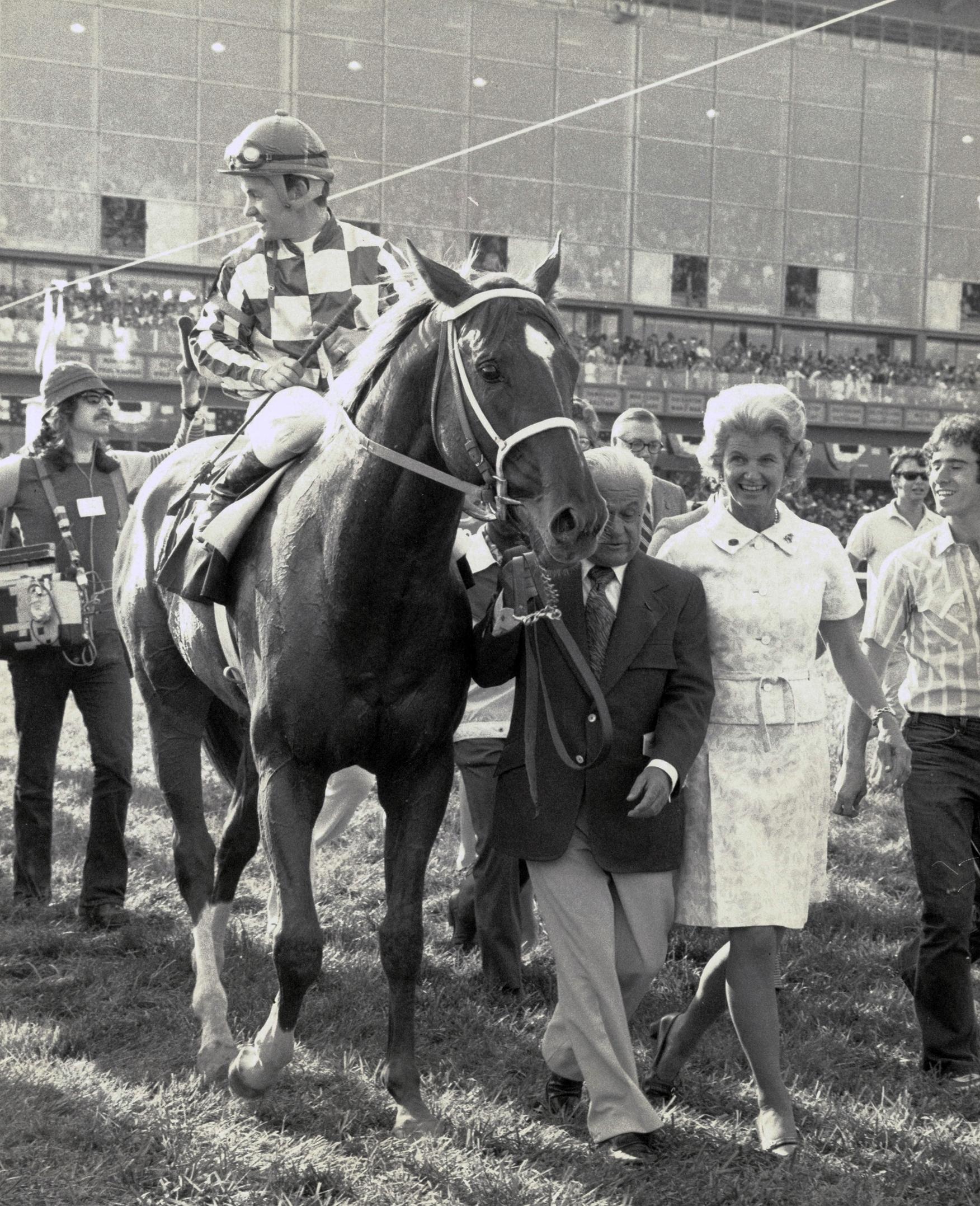
ABR Sunday Selections: Full-Card Picks for Opening Day at Santa Anita

It’s a good thing the connections of Secretariat had their confidence built up by their star’s performance in winning the Kentucky Derby, because they needed every bit of it to fend off the demons and bad omens that swirled around the Preakness Stakes at Pimlico Race Course, May 19, 1973.
On Preakness Day, Penny (Chenery) Tweedy was eating lunch at a Baltimore hotel when a valet smashed her car. Track officials messed up her credentials, which were not at the special gate she was supposed to enter. Then someone lifted her husband’s wallet.
“There were a lot of hitches,” Chenery remembered 40 years later. “All that was inconvenient, but it didn’t upset me. I knew the show wasn’t going to go on without us.”
Indeed, the star of the show was the gargantuan chestnut colt who had easily dispatched a dozen foes two weeks earlier in Louisville, Ky., and was two races away from accomplishing the first Triple Crown in 25 years. Racing in the name of the Chenery family’s Meadow Stable, Secretariat had exited the Derby in fine shape and taken up a less eventful residence in Baltimore than his connections encountered. A year earlier, however, the Preakness tripped up Meadow’s Riva Ridge, who had won the Derby and would go on to win the Belmont Stakes.
“The Preakness was the race that concerned me, because of Riva’s loss,” said Chenery. “I don’t know why because they were entirely different horses, but I was anxious about the race.”
Chenery busied herself with a full slate of social events before the second leg of the Triple Crown. She knew more people there than in Kentucky and was also more relaxed with the Derby already spoken for.
“Baltimore is a friendly city, and they know how to put on a good party and entertain you,” she said. “We went to a lot of events before the Preakness. Socially, it was more fun for me. And the people from the farm [The Meadow in Virginia] came up, which was nice.”

Trainer Lucien Laurin eased back on Secretariat’s normal routine after the Derby, sending him out for gallops for a week. The Derby winner’s major piece of work came the Sunday before the Preakness. His regular rider, Ron Turcotte, came down from New York to breeze him.
“We worked him three-quarters, a little farther than usual because we didn’t want to work him as fast on top of the next race,” said Turcotte.
Nevertheless, Secretariat whipped through his drill, a half-mile in :45 1/5, five-eighths in :57 2/5, and six furlongs in 1:10. If the Derby had taken anything out of him, he sure wasn’t showing it. The day before the Preakness, Turcotte let Secretariat run through the Pimlico stretch, and the preparations were concluded.
A then-record crowd of nearly 62,000 flooded Pimlico to see the most expensive horse in the world vie for the second jewel of the Triple Crown, but the equine population for the Preakness shrank considerably from the Derby field. Only five entered the starting gate to face Secretariat, including Derby second-place finisher Sham and the speedy Ecole Etage.
Up in the stands the Chenery party was finally ensconced in its box along with some surprise guests.
“The thing that amused me,” said Chenery, “was that Lucien brought some nuns along with him. I don’t know where he encountered these ladies because I never knew Lucien to go to church. If you look at the photos of us watching the race, there are three nuns with us, very nice ladies.”
Most figured Secretariat didn’t need much divine intervention, and he was bet down to 30 cents on the dollar. Bud Delp, who would later become famous for training Spectacular Bid, told his jockey George Cusimano to hustle Ecole Etage from the gate, and he did so, clearing the field from the outside post and dropping down inside to save ground. Fractions for the race are a little tricky because the track teletimer malfunctioned, but Ecole Etage went the first quarter in a racy :23 or so.
“Once he made the lead on the first turn he tried to take hold and slow the pace down,” said Turcotte. “I was getting ready to drop Secretariat in, but I looked up and saw that everybody was sitting back on their horses, so I decided to wheel Secretariat out. All the others were backing up and settling down, and mine was moving good and easy under me. I didn’t intend to go straight to the lead.”
In one of the most famous moves in racing history, Secretariat ran past his field on the outside on the first turn. Forget about saving ground or moving prematurely or any of the other axioms that rule racing for mere mortals. He was on the lead when he hit the backstretch run.
“I thought I was making the right move,” Turcotte said. “It was a chance I thought I had to take. We moved by everybody and I dropped him down on the rail and dropped his head again and he went back to relaxing.”
Earlier in the year, Turcotte and Laurin had experimented with Secretariat, sending him to the front in the Gotham Stakes to gain him experience should he want to show early speed. That strategy helped him here, although trainer and owner were not convinced right away.
“Somebody told me later Lucien was saying, ‘He’s blowing it; he’s blowing it,’ and 99.9% of trainers would have thought the same thing,” noted Turcotte. “Of course, afterward, he was praising my ride.”
Said Chenery, “I thought Ronny had lost his mind. The horse doesn’t run this way, so what was he doing? But it was a spectacular move. For dramatic effect, it was wonderful. There was concern he moved too soon and somebody would catch him.”
Turcotte had no such doubts.
“I got on him all the time, and he always did what I asked; I knew exactly how he felt underneath. He was a very controllable horse, a manageable horse.”
Secretariat led by a half-length after a half-mile, and spurted forward with a half-mile to run, switching leads and opening up by more than two lengths from Sham.
“[Laffit] Pincay began chirping to Sham and asking him, but Secretariat really picked it up and ran well that last quarter,” said Turcotte. “I looked under my arm for Sham and I couldn’t see him, so I knew he wasn’t that close to me.”
While Pincay was pushing on Sham for all he was worth, Turcotte let Secretariat run on his own.
“I kept thinking ‘Belmont,’ ” Turcotte said. “He could have won by a lot farther, but there was no point asking him for any more. I was thinking about saving some for the next one.”

Secretariat crossed the finish line as he had in the Derby, 2 1/2 lengths clear of Sham, the Preakness timed in 1:55. But that was immediately disputed by clockers and reporters. The clocking was moved to 1:54 2/5, but that didn’t satisfy anybody who believed Secretariat had been cheated out of a race record. It wasn’t until 39 years later, in 2012, when, using evidence compiled by Leonard Lusky of Secretariat.com from various videotapes of the race, the Maryland Racing Commission agreed to lower the official clocking to 1:53.14, giving Secretariat the Preakness record.
Compared with the Derby aftermath, the Meadow Stable contingent seemed very businesslike in the moments after the Preakness. Penny Chenery calmly led the entourage out of the boxes and down toward the winner’s circle as if they were filing out of a lunch meeting.
“Well, yes, because we were on a mission,” she said in 2013. “We got one down, and now we had the second.”
Turcotte smiled inside as he heard Laurin compliment his ride after the race. He had an unshakable confidence that he knew this horse better than anybody, and two races after his shocking loss in the Wood Memorial Stakes, Turcotte was going to stick to his guns come hell or high water.
“I’ve ridden horses where I had orders to take them back, but you get a slow pace and you put them up close and win the race and the trainer says to the press, ‘He rode him just like I told him,’ ” Turcotte said with a laugh.
“What are you going to say? I don’t need to fight with them.”
BloodHorse Daily is celebrating the 50th anniversary of Secretariat’s Triple Crown season by tapping Lenny Shulman’s wonderful look back at each of his 1973 races on the calendar dates of those events. Shulman’s series helped celebrate the 40th anniversary in BloodHorse Magazine.
The June issue of BloodHorse Magazine will feature a trio of stories related to Secretariat, including a look at his records standing the test of time, his legacy in the breed, and his impact on those people who were around him.
Also keep an eye out for other special stories and features on BloodHorse platforms and in social media.